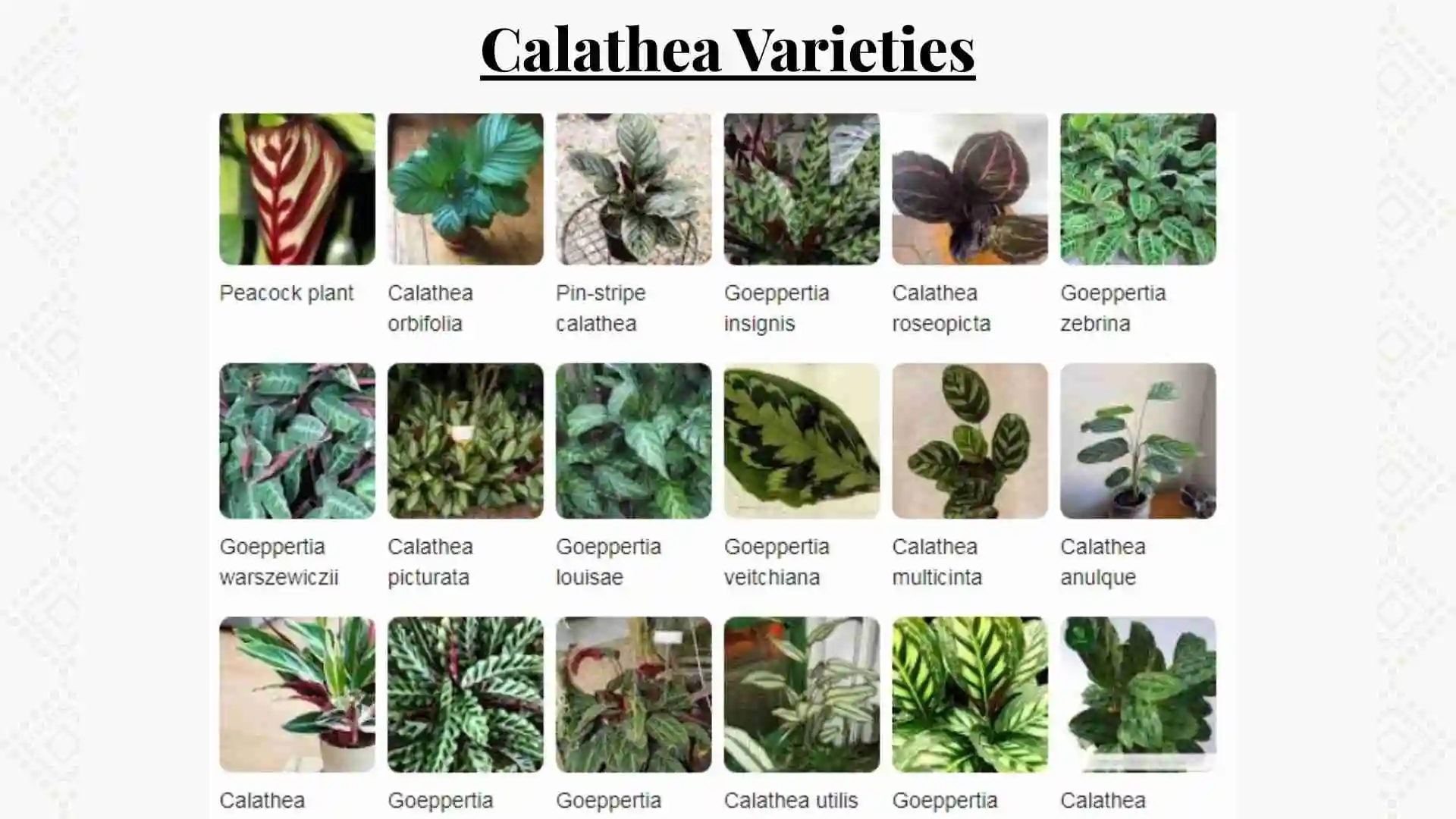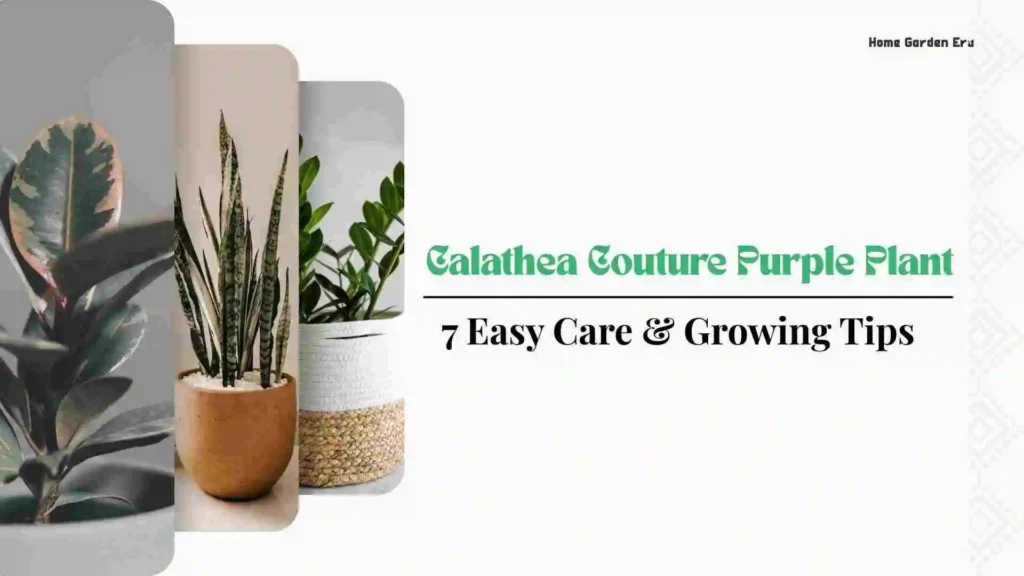The Calathea Couture Purple Plant is a stunning indoor plant admired for its vibrant purple leaves and intricate foliage patterns.
This tropical houseplant adds elegance and colour to any space, making it a popular choice for homes and offices alike.
with the right balance of humidity, warmth and watering, it is relatively easy to care for – even for beginners.
In this article, we”ll explore the unique features of this plant along with 07 easy care and growing tips to help you keep your Couture Purple Calatheas healthy and thriving.
Table of Contents
Calathea Couture Purple Plant :

Calathea Couture Purple is a very attractive indoor ornamental plant. This plant stands out for its deep purple foliage, beautifully accented with delicate pink and silver stripes along the edges.
Its color combination makes it completely different from other Calatheas Plants. This plant is very much liked for its deep purple leaves and pink-silver stripes on them.
The word ” Couture” refers to its stylish and premium look.
Calathea Couture Purple is a type of Calatheas species, which is naturally found in tropical forests, where it prefers moist and shady environments.
This distinct variety stands apart from common green-leaf Calatheas with its bold, deep purple leaves.
Due to its unique color and design, it not only enhances the beauty of the house but has also become quite popular as a stylish indoor plant today.
What is a Calathea Plant ?
Known for its bold patterns and vibrant leaves, Calathea is a tropical plant commonly used in indoor gardening.
It is popular among gardeners for its vibrant, showy, decorative and intricately patterned leaves.
Its name is thought to have Latin origins linked to the word for ‘basket‘, which may reflect how parts of the plant were once used in weaving.
Its striking foliage has also earned it nicknames like the Prayer plant, Peacock plant, and Rattlesnake plant.
It primarily belongs to the family Marantaceae, but many species are now classified in a new genus called GOEPPERTIA.
While its originates from the dense rainforests of Central and South America, it is most commonly seen flourishing in Brazil.
Calatheas are known for their large, colorfully patterned leaves that display a variety of colors, including shades of green, purple, silver, and cream.
The leaves curl upward in the evening, looking like someone’s praying hands, and open up again with the morning light.
With a preference for warm climates, airy soil, and a humid atmosphere, Calatheas grow best indoors where indirect light is available.
In short, Calathea are decorative, pet-friendly indoor plants that bring tropical charm and beauty to your homes/offices
Types of Calathea plants :

Calatheas is very popular among people due to its many attractive varieties.
At present, hundreds of its varieties are available, some of the most popular species of which are given below.
- Peacock Plant
- Calathea Orbifolia
- Pin – stripe Calatheas
- Goeppertia
- Roseopicta
- Goeppertia Zebrina
- Goeppertia Warszewiczii
- Goeppertia Louisae
- Calatheas Picturata
- Goeppertia veitchiana
- Calathea Couture Purple Plant
7 Easy Care & Growing Tips for Calathea Couture Purple Plant

Calatheas are popular indoor plants, admired for their vivid colors and distinctively patterned leaves that add a touch of elegance to any space.
It adds a vibrant and decorative touch to any room and is perfect for those who want to bring a natural ambiance to their Home Garden.
To ensure healthy growth, Calatheas plants should be placed in conditions that closely mimic their warm and humid tropical habitat.
This involves offering filtered light, ensuring high humidity levels, and keeping the environment consistently warm.
With proper care, this plant not only stays healthy but continues to grow beautifully. Below are 7 easy tips for caring for and successfully growing your Calatheas Couture Purple plant:
01 – Choose the Right Spot with Bright, Indirect Light
Calathea Couture Purple Plant grows best in indirect light. Direct exposure to bright sunlight can damage its delicate leaves, which can also ruin their vibrant colors.
To ensure healthy growth and vibrant leaves, place the plant in a spot that receives filtered or diffused light.
02 – moist and well-drained soil
Calatheas thrives in well-drained, slightly acidic soil. Proper drainage is essential to prevent waterlogging and root rot, which are common problems in compacted or wet soil.
For best growth, use a light, airy potting mix that retains moisture without being overly wet.
Calathea thrives in soil that remains slightly moist at all times—avoid overwatering, as soggy soil can lead to root rot.
Let the upper surface of the soil dry out a bit before giving your Calatheas its next watering to avoid overwatering.
Overwatering or underwatering can both cause stress and lead to browning leaf edges. For best results, water the plant using filtered, rain, or distilled water to avoid chemical build up in the soil.
03 – Warm Temperatures and High Humidity
Calathea Couture Purple grows best in warm, humid conditions that mimic the tropical climate of its native environment.
For best results, maintain indoor temperatures between 18°C to 27°C (65°F to 78°F).
Keep the plant away from cold drafts, air conditioning units, and heating vents, as abrupt temperature shifts may lead to wilting leaves
Humidity plays a crucial role in the healthy growth of Calatheas Couture Purple.
Maintaining proper humidity not only supports lush growth but also helps prevent common pests like spider mites, which tend to infest plants in dry conditions.
04 – Fertilizers and their Nutrient content
Calathea Couture Purple typically has its active growth period from spring to early fall.
To promote healthy leaves and vibrant growth, use a balanced, water-soluble houseplant fertilizer once a month during spring and summer.
As growth slows in fall, reduce fertilizing to once every two months. During winter, the plant enters a dormant phase, so it is best to avoid fertilizing altogether.
Over-Fertilizing during this time can cause salt accumulation in the soil and damage the roots. Always fertilize moist soil and avoid over-fertilizing, as Calatheas are sensitive to excess nutrients.
05 – Pruning and cleaning the leaves at regular intervals
Calathea does not require frequent pruning, but occasional maintenance can enhance its appearance and health.
If you notice any leaves with brown or dry edges, trim them carefully using clean, sharp scissors.
Removing dead or damaged leaves allows the plant to redirect its energy toward producing fresh, healthy foliage.
In addition to light pruning, it’s important to keep the leaves clean. Use a soft, damp cloth to gently clean the leaves and remove any accumulated dust or dirt.
Regular cleaning not only keeps the plant looking fresh and attractive but also improves photosynthesis by allowing more light to reach the leaf surface.
06 – Repot for Stronger Roots
To support healthy root development and continued growth, Calatheas Couture Purple should be repotted every 1 to 2 years.
As the plant matures, its roots expand and need more space, while the nutrients in the old soil begin to deplete.
Repotting ensures that the plant has access to fresh, nutrient-rich soil and proper drainage.
The ideal time to repot is during spring, when the plant enters its active growing phase.
While transferring a plant from one pot to another, care should be taken to ensure that its roots are not harmed.
After repotting, water the plant lightly and place it in a shaded area for a few days to help it adjust to its new environment.
07 – Protection from pests
Regular inspection is important to keep Calatheas Couture Purple free from pests.
Inspect both sides of leaves (upper and lower) weekly to ensure they remain healthy and pest-free.
Common signs of pest infestation include white spots, fine webbing and sticky residue, which may indicate the presence of spider mites, mealybugs or aphids.
At the first sign of a problem, take immediate action to prevent the infestation from spreading.
The safest and most effective organic remedy is neem oil spray, which helps control pests without harming the plant.
Apply neem oil thoroughly to all parts of the leaves, paying special attention to the underside where pests commonly take shelter.
Avoid using harsh chemical pesticides, as Calathea leaves are delicate and sensitive.
Instead, use natural and organic pest control methods to protect both your plant and the environment.
Calathea Plant FAQ’s :
People have many kinds of curiosity about the Calathea Couture plant and its care.
Below are given easy answers to some common and important questions, which will not only help in taking better care of this plant but will also clear the doubts related to it.
Calathea Couture Purple indoor or outdoor
Calathea Couture Purple is an indoor plant. This plant prefers high humidity and stable temperature, which can be easily maintained in indoor environments.
Are calathea plants toxic to cats and dogs ?
No, Calathea plants are entirely pet-friendly and classified as non-toxic to both cats and dogs..
These indoor plants are safe for homes with pets, making them a worry-free choice for pet owners.
How to save a dying calathea plant ?
Place the plant in indirect light, keep the soil lightly moist at all times, and use a humidifier or tray of water to increase humidity.
Remove dead leaves and repot the plant in new soil if necessary.
is calathea couture purple a Perennial or Annual?
Calathea Couture Purple is a perennial plant that survives and grows year after year with the right care. Its leaves regrow every season.
Can Calathea couture purple be planted outside?
Yes, but only in regions where the climate is warm and humid. It is not advisable to plant it outdoors in cold or hot sun places.
It is better to keep it indoor or in a shaded place.
Calathea couture purple real or fake
Calathea Couture Purple is an authentic and naturally grown plant. The name is often used commercially to highlight its distinctive beauty and striking color.
This is a popular variety of Calathea with deep purple leaves.
Conclusion
In the above article, we explored Calathea Couture Purple Plant: 7 Easy Care & Growing Tips in detail, providing you with helpful insights to care for and grow this stunning indoor plant.
These simple tips will support your plant’s health and enhance its natural beauty over time.
Have any questions, suggestions or feedback? Write in the comments — we are here to help you every step of the way.
